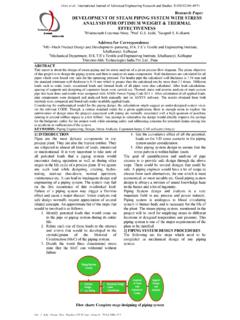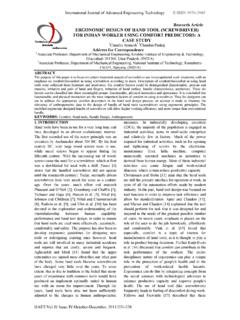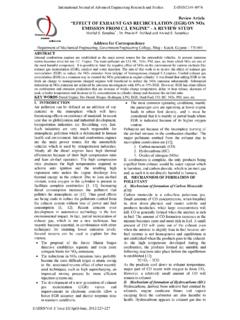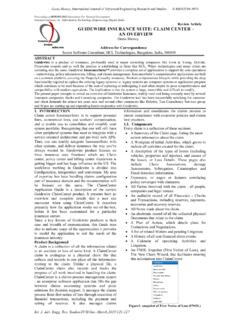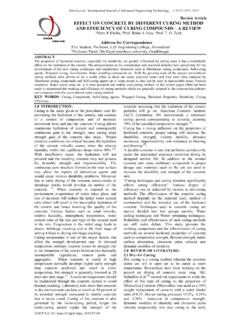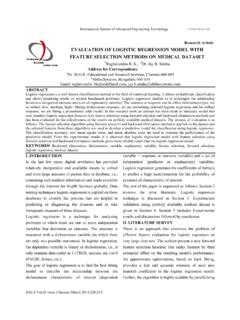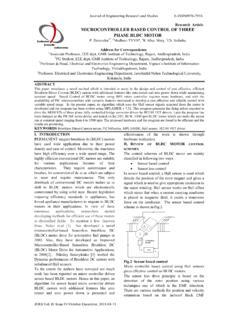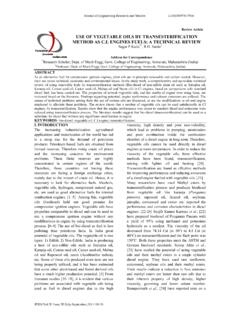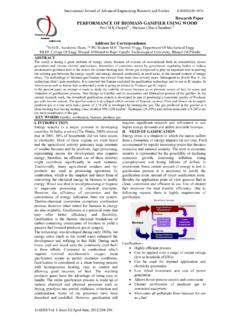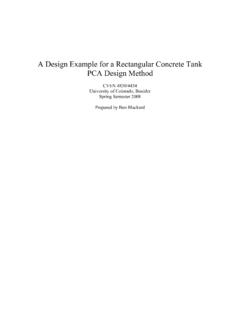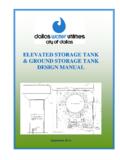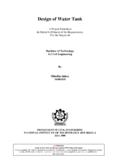Transcription of Research Paper STRUCTURAL CONTROL SYSTEM FOR …
1 International Journal of Advanced Engineering Research and Studies E-ISSN2249 8974 IJAERS/Vol. I/ Issue III/April-June, 2012/325-328 Research Paper STRUCTURAL CONTROL SYSTEM FOR ELEVATED water TANK Asari Falguni P1, Address for Correspondence 1 Research Scholar, 2 Professor and Head, Applied Mechanics Department, L. D. College of Engineering, Gujarat Technological University, Ahmadabad, Gujarat (India) ABSTRACT The Paper presents the results of an analytical investigation of the seismic response of elevated water tanks using fiction damper.
2 In This Paper , the behavior of RCC elevated water tank is studied with using friction damper (FD). For FD SYSTEM , the main step is to determine the slip load. In nonlinear dynamic analysis, the response of structure for three earthquake time history has been carried out to obtained the values of tower drift base shear and acceleration Time Period. These values are compared with original structure. Results of the elevated tank with FD are compared to the corresponding fixed-base tank design and indicate that friction damper is effective in reducing the tower drift, base shear, time period, and roof acceleration for the full range of tank capacities. The obtained results shows that performance of Elevated water tank with FD is better than without FD.
3 KEYWORDS Friction damper, Elevated water tank, Seismic Response , STRUCTURAL CONTROL SYSTEM , Earthquake Engineering. I. INTRODUCTION The elevated water Tank (WT) consists of tank supported by staging SYSTEM composed of columns, braces and foundations. Elevated WTs have generally performed well in a seismic zones. However large number of tank collapses has been observed during earthquakes from, as early as the 1906 San Francisco Earthquake to the 2001 Bhuj Earthquake. [5] The observed damages in recent earthquakes shows that it is necessary to choose new methods in improvement designing of structures. In many earthquake prone countries, buildings as well as water tanks are continuously being retrofitted or constructed with CONTROL devices to reduce stresses, displacements and base shear during seismic activity.
4 The three main types of CONTROL devices employed in structures are active CONTROL , semi-active CONTROL and passive CONTROL . There are several different types of passive devices and dampers are the part of these seismic controls. Passive friction dampers utilize Coulomb friction to dissipate energy from a structure. These dampers used widely in many retrofitting projects all over the world, because of their low cost and good performance [1]. A. Passive CONTROL SYSTEM Passive dampers are the oldest and most common form of CONTROL devices. Passive devices are commonly placed in the cross bracing between two adjacent braced floors.
5 They directly use the displacement of these floors to produce a damping force on the elevated water tank. Unlike active and semi-active devices, passive devices cannot change their damping properties based on the structure s response and therefore do not require any power or CONTROL algorithms to operate. Without any type of sensing equipment or computation, passive devices are generally the least expensive and most widely used devices [1]. Passive CONTROL systems based on elements distributed throughout the height of main structure are recognized as a more suitable approach for seismic CONTROL of high rise and slender buildings.
6 There is no conceptual difference between the ductile design and the energy dissipation approach. In both cases the structure is expected to CONTROL the floor displacements and storey shear forces by developing non-linear deformation mechanisms which will both dissipate large amounts of seismic energy [1]. Friction dampers are the prevalent of these passive CONTROL systems, because of using in different kind of braces, low cost and suitable efficiency [4]. B. Friction Damper (FD) These devices rely on the resistance developed between two solid interfaces sliding relative to one another [2]. Frictional forces arising from the relative motion of two contacting surfaces are a well-known source of energy dissipation.
7 Sometimes this is an unwanted effect of the design , but it can also be intentionally used to increase the damping of a certain SYSTEM in a simple and cost-effective way. During severe seismic excitations, the friction damper slips at a predetermined load, providing the desired energy dissipation by friction while at the same time shifting the STRUCTURAL fundamental mode away from the earthquake resonant frequency. Another attractive feature of friction dampers is that they offer stiffness in conjunction with supple-mental damping. While supplemental damping is beneficial in reducing the earthquake forces and amplitudes of vibration, added stiffness is beneficial for stability.
8 [3] Although friction has been used effectively to CONTROL motion for centuries, the development of friction devices for use in civil structures to CONTROL seismic response was pioneered in the late eighties [5]. Several design variations of these dampers have been studied in the literature and different forms of patented hardware, now available commercially are X-braced friction, diagonal braced friction and chevron braced friction, slotted bolted connection and Sumitomo friction [1]. These devices differ in their mechanical complexity and in the materials used for the sliding surfaces. In this Paper only diagonal friction dampers are studied for analysis.
9 C. Slip Load For friction dampers, the main step is to determine the slip load. The value of dissipated energy subjected to FD is product of slip load and drift of all International Journal of Advanced Engineering Research and Studies E-ISSN2249 8974 IJAERS/Vol. I/ Issue III/April-June, 2012/325-328 dampers. Therefore dissipated energy of structure with FD is depended to slip load. If the slip load is chosen much, the STRUCTURAL SYSTEM acts such as braced frame and if this amount is chosen low, the damper does not slip and cannot CONTROL drift in structure, between these amounts the proper slip load is existed that is obtained from nonlinear dynamic analysis.
10 The natural frequencies and mode shapes are determined, and a response spectrum analysis is conducted. Results are investigated for the full tank. [1] For finding the optimum slip load we select 0 to 30% base shear obtain by response spectrum analysis. D. Nonlinear Dynamic Analysis The slip load of friction damper in an elastic brace constitutes nonlinearity. Therefore, the analysis and design of water tank requires the use of nonlinear time-history dynamic analysis. With these analyses, the time-history response of the structure during and after an earthquake can be accurately understood [1]. As different earthquake records even though of the same intensity, give widely varying STRUCTURAL response, the results obtained using a single record may not be conclusive.
